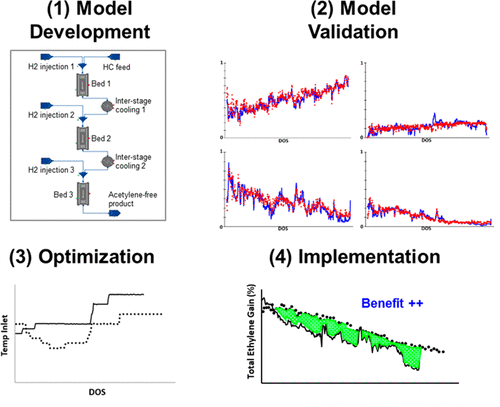当前位置:
X-MOL 学术
›
Ind. Eng. Chem. Res.
›
论文详情
Our official English website, www.x-mol.net, welcomes your
feedback! (Note: you will need to create a separate account there.)
Model-Based Optimization of an Acetylene Hydrogenation Reactor To Improve Overall Ethylene Plant Economics
Industrial & Engineering Chemistry Research ( IF 3.8 ) Pub Date : 2018-07-24 , DOI: 10.1021/acs.iecr.7b05234 Hattachai Aeowjaroenlap 1 , Kritsada Chotiwiriyakun 1 , Nattawat Tiensai 1 , Wiwut Tanthapanichakoon 1 , Stepan Spatenka 2 , Alejandro Cano 2
Industrial & Engineering Chemistry Research ( IF 3.8 ) Pub Date : 2018-07-24 , DOI: 10.1021/acs.iecr.7b05234 Hattachai Aeowjaroenlap 1 , Kritsada Chotiwiriyakun 1 , Nattawat Tiensai 1 , Wiwut Tanthapanichakoon 1 , Stepan Spatenka 2 , Alejandro Cano 2
Affiliation

|
The steam cracking process is a common technology for producing ethylene from naphtha. However, one of the major contaminants in the ethylene product stream is acetylene, which poisons catalysts used in downstream polymerization processes and must be converted to ethylene by selective catalytic hydrogenation in order to upgrade product quality and increase overall ethylene yield. The selective hydrogenation process is usually carried out in a multistage fixed-bed catalytic reactor with internal cooling between stages to ensure that the outlet concentration of acetylene does not exceed 1 ppm. Nevertheless, side reactions also occur, including total hydrogenation to ethane, which increases energy consumption at the recycle furnace and decreases overall plant productivity. Moreover, in a tail-end hydrogenation process, the catalyst surface often becomes covered by so-called green oil generated from acetylene oligomerization, which causes catalyst deactivation and lowers the selectivity to ethylene. A key challenge of the tail-end acetylene hydrogenation process is to maximize the selectivity to ethylene while maintaining a full conversion of acetylene and maximizing the run length between catalyst regenerations. In this work, a model of the tail-end three-stage fixed-bed catalytic selective hydrogenation reactor was developed and validated to accurately predict the reactor outlet composition and other important variables. To achieve the optimum operating policy, the model-based dynamic optimization was applied to maximize overall process economics through enhancement of selectivity to production of ethylene. Implementation of the optimal operating policy on a commercial acetylene hydrogenation reactor resulted in a 13% improvement of ethylene selectivity and 10% increase of overall process economics while simultaneously decreasing the rate of catalyst deactivation. This modeling and optimization approach should be applicable to other fixed-bed hydrogenation processes, such as hydrogenation of methyl acetylene and propadiene in propylene product stream.
中文翻译:

基于模型的乙炔加氢反应器优化,以提高乙烯装置的整体经济效益
蒸汽裂化工艺是从石脑油生产乙烯的常用技术。但是,乙烯产物流中的主要污染物之一是乙炔,乙炔会毒害下游聚合工艺中使用的催化剂,必须通过选择性催化加氢将其转化为乙烯,以提高产品质量并提高总乙烯收率。选择性氢化过程通常在多级固定床催化反应器中进行,各级之间进行内部冷却,以确保乙炔的出口浓度不超过1 ppm。但是,也会发生副反应,包括加氢成乙烷,这会增加循环炉的能耗并降低工厂的整体生产率。此外,在尾部加氢过程中 催化剂表面经常被乙炔低聚生成的所谓绿色油所覆盖,这会导致催化剂失活并降低对乙烯的选择性。尾端乙炔加氢过程的关键挑战是在保持乙炔的完全转化并最大化催化剂再生之间的运行时间的同时,最大化对乙烯的选择性。在这项工作中,开发并验证了尾部三级固定床催化选择性加氢反应器的模型,以准确预测反应器出口组成和其他重要变量。为了获得最佳的操作策略,基于模型的动态优化通过增强对乙烯生产的选择性而被应用以最大化整个过程的经济性。在商业乙炔加氢反应器上实施最佳操作策略导致乙烯选择性提高了13%,总体工艺经济性提高了10%,同时降低了催化剂的失活速率。这种建模和优化方法应适用于其他固定床加氢工艺,例如丙烯产品流中甲基乙炔和丙二烯的加氢。
更新日期:2018-07-24
中文翻译:

基于模型的乙炔加氢反应器优化,以提高乙烯装置的整体经济效益
蒸汽裂化工艺是从石脑油生产乙烯的常用技术。但是,乙烯产物流中的主要污染物之一是乙炔,乙炔会毒害下游聚合工艺中使用的催化剂,必须通过选择性催化加氢将其转化为乙烯,以提高产品质量并提高总乙烯收率。选择性氢化过程通常在多级固定床催化反应器中进行,各级之间进行内部冷却,以确保乙炔的出口浓度不超过1 ppm。但是,也会发生副反应,包括加氢成乙烷,这会增加循环炉的能耗并降低工厂的整体生产率。此外,在尾部加氢过程中 催化剂表面经常被乙炔低聚生成的所谓绿色油所覆盖,这会导致催化剂失活并降低对乙烯的选择性。尾端乙炔加氢过程的关键挑战是在保持乙炔的完全转化并最大化催化剂再生之间的运行时间的同时,最大化对乙烯的选择性。在这项工作中,开发并验证了尾部三级固定床催化选择性加氢反应器的模型,以准确预测反应器出口组成和其他重要变量。为了获得最佳的操作策略,基于模型的动态优化通过增强对乙烯生产的选择性而被应用以最大化整个过程的经济性。在商业乙炔加氢反应器上实施最佳操作策略导致乙烯选择性提高了13%,总体工艺经济性提高了10%,同时降低了催化剂的失活速率。这种建模和优化方法应适用于其他固定床加氢工艺,例如丙烯产品流中甲基乙炔和丙二烯的加氢。


















































 京公网安备 11010802027423号
京公网安备 11010802027423号